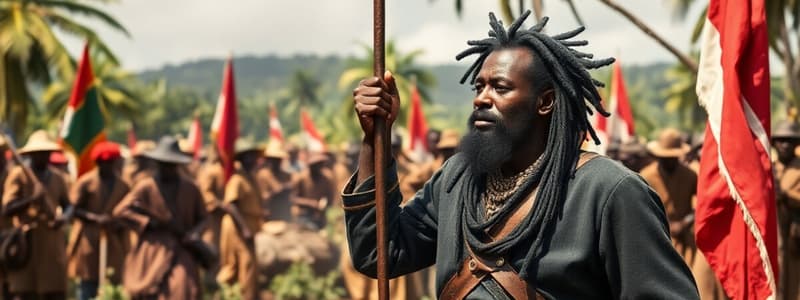Podcast
Questions and Answers
What strategy did Samuel Sharpe primarily advocate for to resist slavery?
What strategy did Samuel Sharpe primarily advocate for to resist slavery?
- Escape to the mountains to form maroon communities
- Nonviolent resistance through a widespread strike (correct)
- Negotiations with the British government for gradual emancipation
- Armed insurrection against plantation owners
The Christmas Rebellion, led by Samuel Sharpe, was immediately successful in achieving the abolition of slavery in Jamaica.
The Christmas Rebellion, led by Samuel Sharpe, was immediately successful in achieving the abolition of slavery in Jamaica.
False (B)
In what parish did the Sam Sharpe Rebellion primarily occur?
In what parish did the Sam Sharpe Rebellion primarily occur?
St. James
Samuel Sharpe, who led the Christmas Rebellion, held the position of ______ in the Baptist Church.
Samuel Sharpe, who led the Christmas Rebellion, held the position of ______ in the Baptist Church.
Match the following parishes with the approximate number of damaged estates during the Christmas Rebellion:
Match the following parishes with the approximate number of damaged estates during the Christmas Rebellion:
What was one of Samuel Sharpe's core beliefs regarding plantation owners and their response to a strike?
What was one of Samuel Sharpe's core beliefs regarding plantation owners and their response to a strike?
Samuel Sharpe's initial plan for the Christmas Rebellion involved widespread violence and the destruction of property.
Samuel Sharpe's initial plan for the Christmas Rebellion involved widespread violence and the destruction of property.
What event on December 28, 1831, is considered the start of the Sam Sharpe Rebellion?
What event on December 28, 1831, is considered the start of the Sam Sharpe Rebellion?
The Sam Sharpe Rebellion lasted for approximately ______ days.
The Sam Sharpe Rebellion lasted for approximately ______ days.
Match the following outcomes to their impact during the Christmas Rebellion::
Match the following outcomes to their impact during the Christmas Rebellion::
Which of the following factors contributed to the ultimate failure of the Christmas Rebellion?
Which of the following factors contributed to the ultimate failure of the Christmas Rebellion?
The Maroons actively supported the enslaved people during the Christmas Rebellion.
The Maroons actively supported the enslaved people during the Christmas Rebellion.
According to provided information. About how many enslaved individuals died as a result of the Christmas Rebellion?
According to provided information. About how many enslaved individuals died as a result of the Christmas Rebellion?
Sharpe spent several months secretly planning and moving from estate to estate organizing and lecturing and ______ the slaves. Whites were unaware of the plan.
Sharpe spent several months secretly planning and moving from estate to estate organizing and lecturing and ______ the slaves. Whites were unaware of the plan.
Match each of the following outcomes with its corresponding result within the Christmas Rebellion:
Match each of the following outcomes with its corresponding result within the Christmas Rebellion:
What was Samuel Sharpe's date of death?
What was Samuel Sharpe's date of death?
Samuel Sharpe was not taught to read and write.
Samuel Sharpe was not taught to read and write.
In what year was Sam Sharpe born?
In what year was Sam Sharpe born?
Sharpe was a class leader and ______ in the Baptist Church.
Sharpe was a class leader and ______ in the Baptist Church.
Match the following historical events with their dates.
Match the following historical events with their dates.
In which place was Samuel Sharpe born?
In which place was Samuel Sharpe born?
Samuel Sharpe's rebellion led to no deaths.
Samuel Sharpe's rebellion led to no deaths.
What was Sharpe's rebellion also known as?
What was Sharpe's rebellion also known as?
The government responded ______ and took action to bring the rebellion to and immediate end.
The government responded ______ and took action to bring the rebellion to and immediate end.
Match the following:
Match the following:
How did the slaves rebellion play an important role in slavery?
How did the slaves rebellion play an important role in slavery?
The whites were aware of the blacks plan.
The whites were aware of the blacks plan.
What estate was burned down to mark the start of the rebellion?
What estate was burned down to mark the start of the rebellion?
The government sent ______ to bring an end to the rebellion.
The government sent ______ to bring an end to the rebellion.
Match the parish to the correct # of damages:
Match the parish to the correct # of damages:
Who was Samuel Sharpe named after?
Who was Samuel Sharpe named after?
The troops were not well trained.
The troops were not well trained.
What two resistance movements did Samuel spearhead?
What two resistance movements did Samuel spearhead?
The rebellion resulted in 14 white ______ or plantation owners.
The rebellion resulted in 14 white ______ or plantation owners.
Match the parishes to the correct # of damaged estates:
Match the parishes to the correct # of damaged estates:
How long did Sharpe plan the rebellion?
How long did Sharpe plan the rebellion?
The enslaved were well organized.
The enslaved were well organized.
What did burning Kensington do?
What did burning Kensington do?
Despite Sharpe's intention for the strike to be ______ events quickly escalated.
Despite Sharpe's intention for the strike to be ______ events quickly escalated.
Match the definition to the proper term.
Match the definition to the proper term.
Flashcards
What is the Sam Sharpe Rebellion?
What is the Sam Sharpe Rebellion?
A rebellion in Jamaica on December 27, 1831, where enslaved people rose against slavery.
Who was Samuel Sharpe?
Who was Samuel Sharpe?
He was a Baptist deacon and enslaved person who led a nonviolent resistance.
What was the initial strategy of the Sam Sharpe Rebellion?
What was the initial strategy of the Sam Sharpe Rebellion?
It was a nonviolent strike organized by Samuel Sharpe, aimed at demanding wages and bringing attention to grievances.
What was the main goal of the Sam Sharpe Rebellion?
What was the main goal of the Sam Sharpe Rebellion?
Signup and view all the flashcards
How did the Sam Sharpe Rebellion escalate?
How did the Sam Sharpe Rebellion escalate?
Signup and view all the flashcards
Besides St. James, where did the rebellion spread?
Besides St. James, where did the rebellion spread?
Signup and view all the flashcards
What were the casualties of the Sam Sharpe Rebellion?
What were the casualties of the Sam Sharpe Rebellion?
Signup and view all the flashcards
Which parishes experienced the most and least destruction?
Which parishes experienced the most and least destruction?
Signup and view all the flashcards
What factors contributed to the failure of the Christmas Rebellion?
What factors contributed to the failure of the Christmas Rebellion?
Signup and view all the flashcards
How did the slaves' rebellion play a major role in the fight against slavery?
How did the slaves' rebellion play a major role in the fight against slavery?
Signup and view all the flashcards
Study Notes
- Sam Sharpe led a rebellion in Jamaica.
Objectives of Studying the Sam Sharpe Rebellion:
- Locate where the Sam Sharpe Rebellion occurred on a map of Jamaica.
- Analyze Sam Sharpe's methods of resistance.
- Assess the success or failure of Sharpe's resistance efforts.
- Understand the effects of these efforts on Jamaica's history.
- Identify examples of slave laws in Jamaica during enslavement.
- Develop empathy for the enslaved people's fight for freedom.
Who Was Sam Sharpe?
- Born in 1780.
- Named after his master, Samuel Sharpe.
- Born in St. James (Croydon Estate).
- Considered a privileged slave because he could read and write.
- He was a class leader and deacon in the Baptist Church.
- Died May 23, 1832.
Location of the Rebellion:
- The Sam Sharpe Rebellion took place in St. James, Jamaica.
The Sam Sharpe Rebellion:
- Also known as the Christmas Rebellion.
- It began on December 27, 1831.
- Enslaved blacks in St. James, Jamaica, rebelled against slavery.
- Samuel Sharpe, an enslaved Baptist deacon, initiated a nonviolent resistance.
- They organized a widespread strike to highlight their grievances and demand wages.
- Sharpe believed plantation owners would address concerns due to the importance of the sugar cane harvest.
- The strike escalated despite intentions for peace.
- The burning of the Kensington Estate Great House on December 28, 1831, signaled the start.
- Violence and fires spread to St. Elizabeth, Manchester, St. Thomas, and Portland.
- The rebellion lasted 8 days.
- About 186 enslaved individuals and 14 white overseers/plantation owners died.
Widespread Destruction:
- Westmoreland had 43 damaged estates.
- Trelawny had 10 damaged estates.
- St. James had 101 damaged estates.
- St. Elizabeth had 23 damaged estates.
- Hanover had 65 damaged estates
Reasons for the Failure of the Christmas Rebellion:
- The government responded quickly to suppress the rebellion.
- Government troops were better equipped and trained.
- There was inadequate leadership, training, organization, and communication among the slaves.
- The local militia received assistance from the Maroons.
- The rebellion demonstrated the enslaved people's willingness to fight for freedom.
- The rebellion helped to fuel the abolition movement.
Extent of Success:
- Sharpe spent months secretly planning the strike, and the whites did not know.
- Gained support from many slaves.
- Sent a message to the whites regarding the dangers of mistreatment.
Points to Consider:
- How the Rebellion expedited emancipation
- Adjectives use to describe Sam Sharpe
Slave Laws:
- Examples of slave laws in Jamaica should be recorded.
Studying That Suits You
Use AI to generate personalized quizzes and flashcards to suit your learning preferences.




